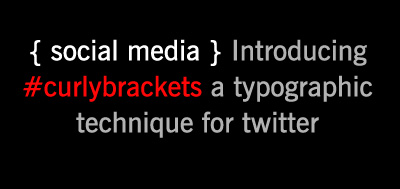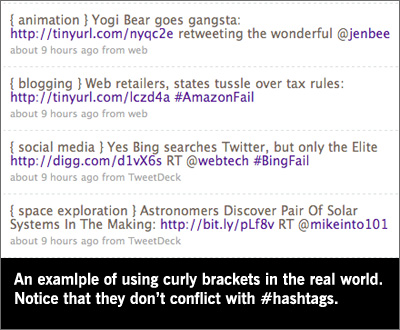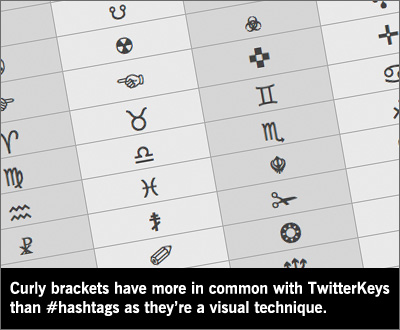{ twitter } What are ‘Curly Brackets’ and when to use them?

Having previously used several social media websites I faced a dilemma when I first started using Twitter: My problem was that several unique groups of people who had very different focuses were following me on Twitter. And Added to that is that I’m a linkaholic who loves to share breaking news and offbeat stories.
To give you a case study of the problem I faced: I’m the publisher of Anime.com which is a website focused on Japanese animation, however I’m also a huge fan of British Post Punk music from the 80s — and for the most part these two virtual communities don’t overlap. So my anime friends don’t care if the Fall announce a tour of the United States, and by contrast my post punk friends think that Lucky Star (らき☆すた) is a song by Madonna.
So I struggled with how to allow my friends to identify which of my tweets are aimed at them. I then noticed that some bloggers were putting brackets in front of their tweets to identify when they were linking to a post vs. writing freestyle tweets. So I took this to the next level and started to use this method to identify a subject that I was tweeting about, so now my anime friends would see { anime } at the start of a tweet and my music buddies would see { punk }:

Now some folks have asked me why I don’t use #hashtags which are now recognized by Twitter. The answer is that hashtags work best for made up words, but there’s no point in using them for natural words. So if you’re at Anime Expo 2009 using the hashtag #ae09 makes a great deal of sense, but using the tag #anime casts too wide of a net.
Also most folks tend to add hastags at the end of their tweet because it’s designed for search — but this means if I’m following your stream that I won’t see your hashtag until after I’ve read your tweet, which is worthless if you get a chatter box like myself. Now you could put the hastags at the front of your tweet, however hastags break once you break a word — and I love subjects that read best as two words like science fiction, post punk and space exploration.
Something important to note is that curly brackets can be used with hashtags because they’re two different things. So for example I might tweet:
{ social media } curly brackets are different than #hashtags.
The curly brackets identify the tweet to my friends who are into social media, so my anime friends can tune out — however the #hashtag allows anyone searching for that made up word to find my tweet. In fact you can make up a hastag that’s called #curlybrackets to allow people to search for the term, and there’s no conflict with having curly brackets in the front.
It’s also important to note that the primary use of curly brackets is visual in nature, search is only a secondary function of this device. However I suggest putting a space between your words and the brackets so Twitter search can find your tweets. In this way if you start your tweet with { anime } a search engine can find your tweet. As a graphic designer I also prefer curly brackets as a visual device because Twitter doesn’t allow you to make text different sizes or even bold or italic. In this way curly brackets allow you to create a headline by eating up 5 character spaces in your tweet.
Now some folks may ask if there’s any sort of rule as to what text you put into a curly bracket: My answer is that while I prefer to use subject matter, you can use what ever you want so long as it gives your tweet a clearer context. So for example you could put { sarcasm } before your tweet to signal the intent of your statement so your friends don’t really believe that Jeff Goldblum is dead. However I like to use uncommon terms that someone might search on like { typography } or even zip codes like { 11211 }. You can also use curly bracket to identify your self identified memberships of your audience. So for example you could use political points of view like { progressive } and { conservative } or even something like { blogging }.

So far I’ve had about two friends start to use this technique. Please note that I refer to it as a “technique” and a “standard” — the difference is that a standard implies some sort of programming functionality (potential or otherwise) and that’s not my intent. Curly brackets are a visual tool to stylize your text to make it more legible within the constraints of twitter. In fact you should think of curly brackets as having more in common with TwitterKeys than with #hashtags. They are first most and foremost a visual device. In fact if you tweet aboutthis article you can add #curlybrackets at the end of your tweet and you’d still be playing within the spirit of { curly brackets }.














